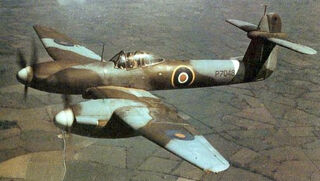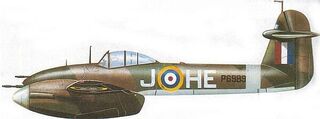For the helicopter with the same name visit:

Westland Whirlwind (helicopter)
The Westland Whirlwind was a British twin-engined heavy fighter developed by Westland Aircraft. It was the Royal Air Force's first single-seat, twin-engined, cannon-armed fighter, and a contemporary of the Supermarine Spitfire and Hawker Hurricane. It was one of the fastest aircraft in service when it flew in the late 1930s, and was much more heavily armed than any other. However, protracted development problems with its Rolls-Royce Peregrine engines delayed the entire project and only a relatively small number were ever built. During the Second World War only two RAF squadrons were equipped with the Whirlwind, and despite successful use as a fighter-bomber it was withdrawn from service in 1943.
Design and development[]
The Air Staff thought that an experimental aircraft armed with the 20mm cannon was needed urgently and Air Ministry specification F.37/35 was issued in 1935. The specification called for a single-seat day and night fighter armed with four cannon. The top speed had to be at least 40 mph (64 km/h) greater than that of contemporary bombers - at least 330 mph (530 km/h) at 15,000 ft (4,570 m).
Eight aircraft designs from five companies were submitted in response to the specification. Boulton Paul offered the P.88A and P.88B (two related single engine designs); Bristol the single-engined Type 153 and the twin-engined Type 153A; Hawker offered a variant of the Hurricane; the Supermarine 312 was a variant of Spitfire and the Supermarine 313 a twin engined design with four guns in the nose and potentially a further two firing through the propeller hubs; the Westland P.9 had two Rolls-Royce Kestrel K.26 engines and a twin tail.
When the designs were considered in May 1936, there were two issues - concern that two engines would be less manoevrable than a single-engined design and that uneven recoil from cannons set in the wings would give less accurate fire. The conference favoured two engines with the cannon set in the nose and recommended the Supermarine 313.
Although Supermarine's efforts were favoured due to their success previously with fast aircraft and the promise of the Spitfire which was undergoing trials, neither they nor Hawker were in a position to deliver a modified version of their single-engined designs quickly enough. Westland which had less work and was more advanced in the project was chosen along with the P.88 and the T

ype 313 for construction. A contract for two P.9s was placed in February 1937 which were expected to be flying in mid-1938. The P.88s were ordered in December along with a Supermarine design to F37/35 but both were cancelled in January.
Westland's design team, under the new leadership of Teddy Petter (who later designed the English Electric Canberra, Lightning and Folland Gnat) designed an aircraft that employed state-of-the-art technology. The magnesium monocoque fuselage was a small tube with a T-tail at the end, although as originally conceived, the design featured a twin tail which was discarded when large Fowler flaps were added that caused large areas of turbulence over the tail unit. The horizontal stabilizer (tailplane) was moved up out of the way of the disturbed air flow caused when the flaps were down. The engines were the Kestrel K.26, later renamed Peregrine, with internal exhaust and leading edge radiators to reduce drag. The airframe was built completely of stressed-skin duraluminium, with the pilot sitting high under one of the world's first full bubble canopies, while the low and forward location of the wing made for superb visibility (except for directly over the nose). Four 20 mm cannon were mounted in the nose; the 600 lb/minute fire rate made it the most heavily armed fighter aircraft of its era. The clustering of the weapons also meant that there were no convergence problems as with wing-mounted guns. Hopes were so high for the design that it remained "top secret" for much of its development, although it had already been mentioned in the French press.
The first prototype (L6844) flew on 11 October 1938, construction had been delayed chiefly due to the new features and also the late delivery of the engines. It was passed to RAE Farnborough at the end of the year. Further Service Trials were carried out at Martlesham Heath. It exhibited excellent handling and was very easy to fly at all speeds. The only exception was the inadequate directional control during takeoff which necessitated an increased rudder area above the tailplane. Production orders were contingent on the success of the test program; delays caused by over 250 modifications to the two prototypes led to an initial production order for 200 aircraft being held up until January 1939 followed by a second order for a similar number, deliveries to fighter squadrons being scheduled to begin in September 1940. Earlier, due to the lower expected production at Westland, there had been suggestions that production should be by other firms and an early 1939 plan to build them at the Castle Bromwich factory was dropped in favour of Spitfire production.
The Whirlwind was quite small, only slightly larger than the Hurricane in overall size, but smaller in terms of frontal area. The landing gear was fully retractable and the entire aircraft was very "clean" with few openings or protuberances. Radiators were in the leading edge on the inner wings rather than below the engines. This careful attention to streamlining and two 885 hp Peregrine engines powered it to over 360 mph (580 km/h), the same speed as the latest single-engine fighters.
But there were problems as well. The aircraft had limited range, under 300 miles combat radius, which made it marginal as an escort. More troublesome were the continued failures of the Peregrine engine. It was originally intended to be one of Rolls' main designs, but the Merlin had become much more important to the war effort and the Peregrine was relegated to a secondary status and development cancelled (there being no other aircraft needing the engine); the first deliveries of Peregrine engines did not reach Westland until January 1940.
By 1940, the Supermarine Spitfire was mounting 20 mm cannons, so the "cannon-armed" requirement was also being met, and by this time the role of escort fighter was becoming less important as RAF Bomber Command turned to night bomber missions. The main qualities the RAF were looking for in a twin-engine fighter were range and carrying capacity (to allow the large radar apparatus of the time to be carried), in which requirements the Bristol Beaufighter could perform just as well as or even better than the Whirlwind.
Development and delivery problems with the Peregrine engines, along with a number of flying accidents and the aircraft’s high landing speed (which restricted the number of airfields from which it could operate), resulted in Whirlwind production being ended in January 1942, after the completion of just 112 production aircraft. Westland campaigned for the creation of a Mk II model, initially designed around a more powerful 1,010 hp Peregrine which was aborted owing to Rolls-Royce's cancellation of further development of the engine. Additional proposals by Petter similarly remained as "paper projects" and included re-engining with Bristol Hercules, American radials and even using two 1,400 hp Merlin XX engines, each concept being rejected by the Air Ministry. Westland were aware that their design - which had been built around the Peregrine - was incapable of being re-engined with anything larger.